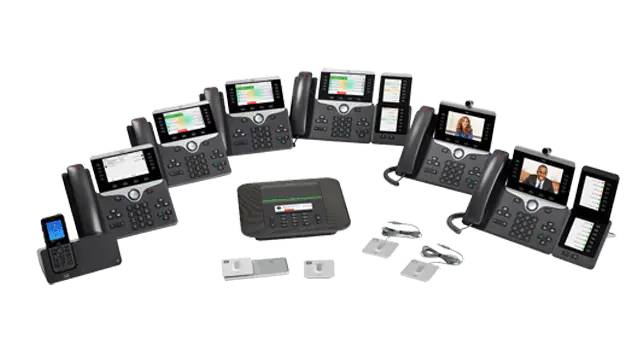TechRadar Verdict
Affordable and offering great audio quality, Cisco's range of IP phones make fantastic all-round choices for businesses.
Pros
- +
Ease of use
- +
Excellent voice quality
- +
Reliable hardware
Cons
- -
GUI could be more intuitive
- -
Earlier models use black and white display
Why you can trust TechRadar
Cisco’s networking heritage really comes to the fore with its three flagship ranges of IP phones: the 6800, 7800, and 8800 series of devices.
This is our all-in-one roundup reviewing three of Cisco's flagship ranges of VoIP devices for 2021. On this page, after our brief intro, you’ll find
(a) a full evaluation of the Cisco IP Phone 6800 range, along with our assessment of the essential features modern businesses depend on
(b) a review of the Cisco IP Phone 7800 range, and
(c) our take on the high-end Cisco IP Phone 8800 range, which offers video support and other UC features
(d) a look at the security protocols that will help you safeguard against emerging threats.
(e) and an examination of the environmental credentials of Cisco's IP handsets.
You can jump to the reviews of those individual products by clicking on the links in the bar at the top of this page but bear in mind that this article is really designed to be read all the way through, as businesses will benefit from assessing all three phone ranges before deciding which one best suits their needs.
The US firm is known as a major player in the IT, networking and cybersecurity sectors and has been making VoIP handsets since the late 1990s. In the intervening years, Cisco has greatly ramped up the features that it includes within its VoIP devices, which can now offer video conferencing tools and artificial intelligence (AI) functionality.
One of the things that makes Cisco’s IP phones so suitable for businesses, regardless of their size, is the range of devices that customers can choose from. From more entry-level offerings all the way up to enterprise-standard handsets, the company understands that no two businesses are the same, and communication needs are changing all the time. Whether organizations plump for a device from the 6800, 7800, or 8800 range, they’ll receive a reliable VoIP phone with a robust suite of features.
Cisco IP Phone 6800 Series

Although the 6800 range may not be as flashy as some of Cisco’s other VoIP offerings, it still delivers reliable, business-grade audio in an energy-efficient package that will appeal to many organizations. Specifically designed for companies with “moderate to active VoIP needs,” the 6800 range gives businesses five models to choose from, depending on their specific needs.
Most of the handsets that make up the 6800 series do come with a greyscale display, which may be disappointing if employees are used to working with color VoIP solutions but, in most cases, these concerns will be forgotten once the high-fidelity audio becomes apparent. Devices in the series also come with fully programmable line buttons, which can be customized for SIP registrations, or call features, like speed dialing.
With the COVID-19 pandemic forcing many businesses to adopt remote working policies, VoIP handsets have become more important than ever for firms wishing to remain in contact with their employees and clients. Fortunately, the 6800 series has a number of specific futures that are aimed at boosting productivity, wherever employees are based. These include the ability to handle multiple calls, fixed-function buttons that provide one-touch access to important features, and localized language support for international users.
Comparing the different models, the Cisco IP Phone 6821 supports two SIP registrations, while the 6841 and 6851 models both support up to four SIP registrations. The 6851 handset also supports the Key Expansion Module, which adds 14 physical buttons along with access to 14 additional on-screen buttons. The extra functionality provided by the module is likely to prove particularly useful for organizations with a larger number of employees.
Sign up to the TechRadar Pro newsletter to get all the top news, opinion, features and guidance your business needs to succeed!
The premium offering within the 6800 range is the Cisco IP Phone 6871, which comes with a color display, six SIP registrations, four soft keys, and a USB-A port. The device is also wall-mountable and comes with power over Ethernet functionality. Unfortunately, even at this end of the scale, there’s little in the way of special features. Don’t expect the screen supplied with the 6871 to deliver high definition visuals, for example.
So while the 6800 range may not offer slick features, it still provides all the core functionality that businesses have come to expect from their VoIP handsets. What’s more, the devices are also supported by Cisco-approved third-party unified communications as a service (UCaaS) providers, so there’s no need for organizations to make-do with a subpar VoIP solution when using these handsets.
Cisco IP Phone 7800 Series

Delivering a more full-featured experience than the 6800 range, the 7800 series offers users four different devices to choose from, all of which are designed to be simple, secure, and energy-efficient. The models are aimed at businesses small to large that wish to improve productivity among their employees.
All of the 7800 models boast the latest security and encryption solutions so organizations need not worry about audio data being intercepted or interfered with. Hash Algorithm 2 (SHA-2) and Transport Layer Security 1.2 are employed to help protect the intellectual property of your business. This security also extends to remote workers, who can connect to the Cisco network using the Cisco Expressway without the need for a dedicated VPN solution when using a 7800 series phone.
There are a number of features included as standard across the 7800 series, including wideband audio and echo cancellation. Overall, businesses should receive a high-quality communication experience when using one of Cisco’s 7800 VoIP handsets, as the company has worked hard to ensure that crystal clear audio is delivered, even among the more affordable models. Vibration isolation has been employed for all the hardware, for example, to ensure that unwanted noises do not distract from the audio experience.
Looking at each particular model in-turn, the 7811 phone is well suited for workers with light VoIP needs. It comes with an IEEE 10/100 integrated switch to support a co-located PC, as well as a 3.28-inch monochrome display. It supports just one phone line and comes with eight fixed feature keys.
The 7821, meanwhile, is ideal for businesses that have slightly more intensive VoIP needs and the model also comes with more aesthetic options, being offered in either charcoal or white designs. It has two lines, a backlit 3.5-inch grayscale display, and is paired with a wall-mount kit for organizations that have limited desk space. The 7841 handset offers all the above and more, offering four programmable line keys that feature tricolor LEDs as call status notifiers.
The most active VoIP users are more likely to need the 7861 device, however, which comes with 16 programmable line keys, as well as 11 fixed feature keys. Interestingly, the handset also comes with a paper insert that users can print locally and customize to allow for one-touch access to frequently used contacts or essential features.
Although the 7800 series still lacks a touch of the glamour that accompanies some higher-end VoIP handsets, it has all the essential features that employees need, and so represents a great choice for moderate VoIP users.
Cisco IP Phone 8800 Series

Boasting nine different models to choose from, Cisco’s 8800 series of IP phones certainly provides businesses with plenty of flexibility. The broad portfolio does come at a cost, particularly when compared with some of the other models offered by Cisco but considering the rich feature list accompanying these handsets, businesses can still feel like they are receiving value for money.
The 8800 series comes at the advanced end of Cisco’s VoIP portfolio and so users can expect top performance, flexible deployment options, and cutting-edge telephony features. Individuals with environmental concerns around purchasing yet another electronic device can also rest assured. Select models within the 8800 range use post-consumer recycled plastic in their construction, demonstrating Cisco’s commitment to furthering the circular economy.
Other features worth looking out for across select 8800 devices are 720p high-definition video output, integrated support for Cisco’s Intelligent Proximity for Mobile Voice when using personal mobile devices, and high-performance audio conferencing for up to 42 participants. Cisco Spark, the company’s cloud-based collaboration suite, can also be deployed with 8800 devices to take part in Spark voice or video calls.
Collectively, the 8800 series includes six desk phone models (the 8811, 8841, 8845, 8851, 8861, and 8865), the IP conference phone 8832, and the 8821 and 8821-EX handsets for in campus mobile workers. Given that collaboration - particularly via video conferencing software - has become increasingly important during the COVID-19 pandemic, the ability to collaborate using high-definition video with 8800 handsets is likely to prove hugely useful.
Some features that are common to the 8811, 8841, 8845, 8851, 8861, and 8865 models include the option of using between five and 10 line keys, increased productivity due to a five-way navigation cluster and four context-sensitive soft-label keys, and fixed keys for the most commonly used features. Power over Ethernet support is also available to help reduce or eliminate the need for local power supplies.
One of the higher-end models offered by Cisco is the IP Phone 8861, which comes with a second USB port for fast-charging other devices, as well as support for 802.11a/b/g/n/ac network protocols. The handset can also be elevated further with the addition of the IP Phone 8851/8861 Key Expansion Module, which supports an additional 84 programmable feature keys to deliver added scalability.
For businesses that really need access to video communication features, without having to employ a separate device, Cisco’s 8800 range ticks a lot of boxes. With security, reliability, and a host of customizable buttons to get to grips with, these VoIP handsets are difficult to beat.
Security

As a result of the COVID-19 pandemic, a great deal of sensitive information that would once have been conveyed in person is now being transmitted via remote communication tools - including VoIP handsets. Unfortunately, cyberattackers have cottoned on to this development and have already launched a number of malicious attempts to steal this vital information. For example, late last year, cybersecurity firm Check Point Research, discovered a cyber fraud operation led by hackers in Gaza, the West Bank, and Egypt that compromised VoIP servers being used by more than 1,200 organizations across 60 countries.
As a result of this evolving threat landscape, VoIP handsets are beginning to take security more seriously. At Cisco, a number of upgraded safeguards have been included alongside its latest models - including the 7800 and 8800 ranges. For example, both models guarantee that only authentic Cisco firmware can be installed on the handsets. The firmware is signed with a 2048-bit RSA key and verified before activation.
Both the 7800 and 8800 series also employ cryptographic identity certificates to ensure added protection. Each phone contains a unique Manufacturing Installed Certificate (MIC) that provides a factory-installed unique identity. At the same time, each phone supports a Local Significant Certificate (LSC) that binds the phones to a customer’s environment.
Altogether, the Cisco 7800 and 8800 phones clearly take security extremely seriously. The handsets provide a number of protections out of the box and they can be administratively hardened via a variety of other security protocols, including encryption and cryptographic algorithms for added protection. If you want a handset that will remain one step ahead of the hackers, the latest Cisco models are worth considering.
Environmental credentials

Sustainability has become an increasingly important concern for businesses across all industries. In order to meet their green ambitions, tackling electronic waste (e-waste) is a prominent concern. Globally, electronic waste generation reached a record high of 53.6 million metric tons in 2019, an increase of 21% in just five years. This is equivalent to approximately 7.3 kilograms of e-waste per person.
E-waste is normally grouped into six categories: temperature-exchange equipment, screens and monitors, lamps, large equipment like washing machines or photocopiers, small equipment, such as cameras and smart speakers, and small IT and telecommunications equipment - including phones. However, the fact that the IP Phone 8800 can lay claim to being Cisco’s first closed-loop plastic product means that it’s a handset that can meet both communicative and environmental needs.

Want to compare Cisco to its rivals? Check out our guide to the best VoIP handsets available today.
Cisco has adopted circular design principles in several of its products by pioneering the use of post-consumer recycled (PCR) plastic. Specific models within the IP Phone 8800 Series now reduce the use of natural resources while closing the loop with its own electronic waste at the same time.
The first step involves sourcing used plastic from Cisco’s electronic waste and separating it appropriately. The PCR is then processed and turned into resin pellets, which are mixed with additives, molded into individual parts, and used to create new products, such as 8800 handsets.
Altogether, Cisco products made with PCR plastic avoid the use of more than 3 million pounds of virgin plastic per year. As well as providing secure, reliable and cost-effective VoIP handsets that boast all the features that a company could need, Cisco also has a handset that will help organizations to meet their sustainability goals.
Cisco VoIP Phone 6800, 7800 and 8800 series: our overall verdict
When looking at the sheer number of different VoIP handsets available across the 6800, 7800, and 8800 ranges, it’s understandable if businesses feel a little overwhelmed.
However, as long as managers and IT leaders have a clear idea of the kind of telephony features they need, there’s certain to be a Cisco phone that fits the bill. The unparalleled range and flexibility provided by these handsets are what makes them such great all-rounders within the VoIP handset space.
- Want to compare Cisco to its rivals? Check out our guide to the best VoIP handsets available
Barclay has been writing about technology for a decade, starting out as a freelancer with ITProPortal covering everything from London’s start-up scene to comparisons of the best cloud storage services. After that, he spent some time as the managing editor of an online outlet focusing on cloud computing, furthering his interest in virtualization, Big Data, and the Internet of Things.

